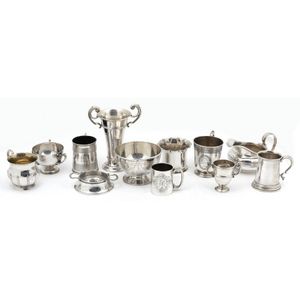Assorted Georgian and Later Silverware Collection
You must be a subscriber, and be logged in to view price and dealer details.
Subscribe Now to view actual auction price for this item
When you subscribe, you have the option of setting the currency in which to display prices to $Au, $US, $NZ or Stg.
- Sterling Silver - Sterling silver is a mixture of 92.5% pure silver and 7.5% of another metal, usually copper. Fine silver is 99.9% pure silver, and is relatively soft and the addition of the very small amount of copper gives the metal enough strength and hardness to be worked into jewellery, decorative and household objects.
- Tankard - A tankard is a drinking vessel for beer, ale, and cider, similar in shape to a large mug, and usually with a hinged lid. Silver tankards were in use in Britain and other parts of Europe from at least the sixteenth century, pewter tankards probably from the thirteenth. In the 19th century a number of ornately carved ivory tankards were produced, but these were designed to demonstrate the skill of the carver, rather than for day to day use. The shapes of tankards vary, sometimes globular, sometimes a tapering concave. For those with lids, the lid usually includes a thumbpiece that the drinker can hold down to keep the lid open. Variation in the design of the thumbpiece include wedge, ball and wedge, ball, hammer head, bud and wedge, double volute (scroll), chair-back, ball and bar, shell, double acorn, corkscrew, and ram's horn.
- Georgian - As an English stylistic period, Georgian is usually taken to cover the period from George I (1714) to the Regency of Prince George (1811-20), although the period from 1800 to 1830 is sometimes designated as the Regency period. During the Georgian period the great English cabinetmakers and designers such as Chippendale, Hepplewhite, Adam Sheraton etc., were all active.
Therefore there isn't a single 'Georgian style' as such and to say something is 'Georgian', usually means it was made between 1714 and 1830. This assumes we discount George V and George VI, both being from the 20th century.
The styles popular at the time of each reign were:
George I (1714-1727) saw out the last years of the Baroque period.
George II (1727-1760) reigned during the Rococo period.
George III (1760-1820) saw the last gasp of the Rococo, all of the early Neo-Classic 'Adam style' and most of the later neo-Classic 'Regency style'.
George IV (Prince Regent 1820-1830)encompassed the last of the 'Regency' style.
William IV's reign (1830-1837) was something of a no man's land (stylistically) and he wasn't a 'George' anyway. He covered the last glimmerings of 'Regency' and the start of the 'Victorian' style. - George Iv - George IV (1762 ? 1830) was king of the United Kingdom of Great Britain and Ireland and king of Hanover from 1820, until his own death in 1830. From 1811 until his accession in 1820, he served as Prince Regent during his father's final mental illness.
In English furniture design, his reign from 1811 to 1830 is known as the Regency period.
This item has been included into following indexes:
Visually similar items

A substantial English oak country-style fourteen seat banquet table, 76 x 310 x 100 cm

Set of ten Antique Russian silver, August Wilhelm Holmstrom marked teaspoons, 265 grams, each 15 cm long (10)

Eero Saarinen (Finnish, 1910-1961), Womb Stool, designed 1948, manufactured by Knoll, cream boucle fabric, chrome plated steel legs, retains manufacturer's decal label, height 38 cm

Nine Russian Imperial silver teaspoons, comprising of a pair and a set of 3 assayed 1891, with 4 various others, 185 grams approx Provenance: Owners fled Russian circa 1917 and settled in Tientsin (Tianjin) China and became part owners of Talati House Hote
